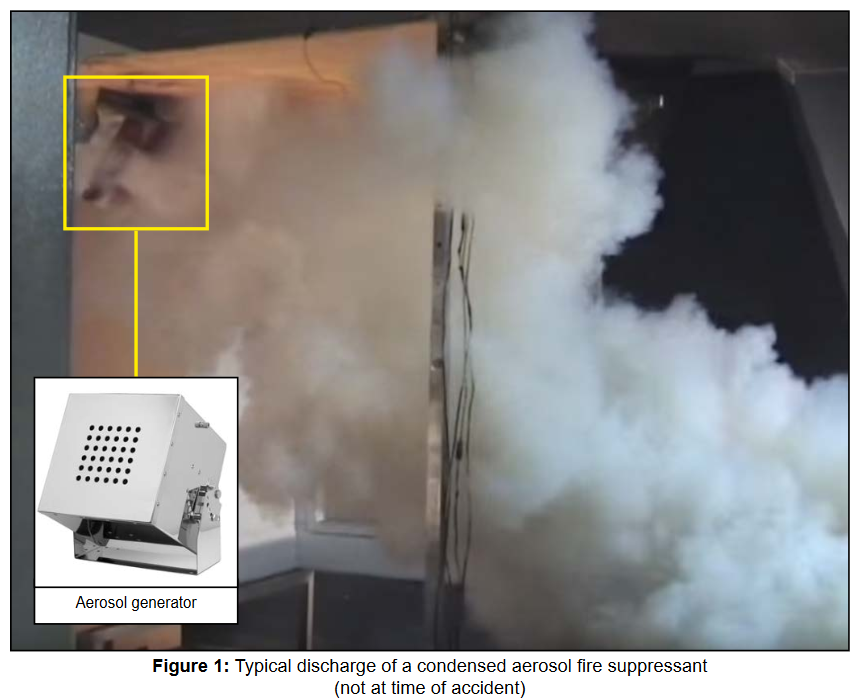Inadvertent activation of condensed aerosol fire extinguishing system leads to a fatality
What happened
The UK Marine Accident Investigation Branch (MAIB) has issued Safety Bulletin SB1/2020 highlighting a potentially serious hazard, associated with condensed aerosol firefighting suppressant particles after a fatal accident on fishing vessel Resurgam.
Fishing vessel Resurgam was alongside undergoing maintenance. An engineer and an apprentice from the owners shore-based support team were working on the main engine in the engine room. Also working in the engine room were two contractors who were installing a new FirePro condensed aerosol fire extinguishing system. During the installation, the fire extinguishing system partially and inadvertently discharged without warning, filling the engine room with a dense cloud of aerosol fire suppressing particles. Both the installation contractors and the company’s engineer managed to evacuate, but the apprentice collapsed in the engine room. He was later recovered by the local fire and rescue service, but found not breathing, and could not be resuscitated.

What were the causes/what went wrong?
The MAIB notes that “the exact causes and circumstances of this accident are still being investigated, and the findings will be published by the MAIB in a full investigation report. However, during the inadvertent discharge, it is evident that the apprentice inhaled a high concentration of the suppressant particles and this contributed significantly to the fatality.”
The manufacturer’s “Installation and User Manual and its product’s material safety data sheets had recognised the inadvertent discharge of the system, particularly during installation and maintenance, as a hazard. However, the loss of life was not identified as a potential outcome; therefore, the risk associated with inhaling or ingesting a large volume of the suppressant particles was not fully appreciated or protected against.”
Actions
The MAIB recommends that “vessel owners, operators and those contracted to install FirePro and other similar condensed aerosol fire extinguishing systems should be fully aware of the potential risk to life from exposure to the aerosol particles.
Safety precautions should be put in place to ensure that personnel are not exposed to this hazard:
- Prior to intentional discharge of a condensed aerosol system, there should be visible and audible alarms to alert personnel. Checks should also be made to ensure the protected compartment has been evacuated before the system is activated.
- When condensed aerosol fire extinguishing systems are being installed or maintained the system should be fully isolated to guard against inadvertent activation, non-essential personnel should be clear of the area and an enclosed space rescue plan should be in place.Fishing vessel Resurgam was alongside undergoing maintenance. An engineer and an apprentice from the owners shore-based support team were working on the main engine in the engine room. Also working in the engine room were two contractors who were installing a new FirePro condensed aerosol fire extinguishing system. During the installation, the fire extinguishing system partially and inadvertently discharged without warning, filling the engine room with a dense cloud of aerosol fire suppressing particles. Both the installation contractors and the company’s engineer managed to evacuate, but the apprentice collapsed in the engine room. He was later recovered by the local fire and rescue service, but found not breathing, and could not be resuscitated.
What were the causes/what went wrong?
The MAIB notes that “the exact causes and circumstances of this accident are still being investigated, and the findings will be published by the MAIB in a full investigation report. However, during the inadvertent discharge, it is evident that the apprentice inhaled a high concentration of the suppressant particles and this contributed significantly to the fatality.”
The manufacturer’s “Installation and User Manual and its product’s material safety data sheets had recognised the inadvertent discharge of the system, particularly during installation and maintenance, as a hazard. However, the loss of life was not identified as a potential outcome; therefore, the risk associated with inhaling or ingesting a large volume of the suppressant particles was not fully appreciated or protected against.”
Actions
The MAIB recommends that “vessel owners, operators and those contracted to install FirePro and other similar condensed aerosol fire extinguishing systems should be fully aware of the potential risk to life from exposure to the aerosol particles.
Safety precautions should be put in place to ensure that personnel are not exposed to this hazard:
- Prior to intentional discharge of a condensed aerosol system, there should be visible and audible alarms to alert personnel. Checks should also be made to ensure the protected compartment has been evacuated before the system is activated.
- When condensed aerosol fire extinguishing systems are being installed or maintained the system should be fully isolated to guard against inadvertent activation, non-essential personnel should be clear of the area and an enclosed space rescue plan should be in place.
Members may wish to refer to: 
Safety Event
Published: 1 June 2020
Download: IMCA SF 17/20
IMCA Safety Flashes
Submit a Report
IMCA Safety Flashes summarise key safety matters and incidents, allowing lessons to be more easily learnt for the benefit of all. The effectiveness of the IMCA Safety Flash system depends on Members sharing information and so avoiding repeat incidents. Please consider adding [email protected] to your internal distribution list for safety alerts or manually submitting information on incidents you consider may be relevant. All information is anonymised or sanitised, as appropriate.
IMCA’s store terms and conditions (https://www.imca-int.com/legal-notices/terms/) apply to all downloads from IMCA’s website, including this document.
IMCA makes every effort to ensure the accuracy and reliability of the data contained in the documents it publishes, but IMCA shall not be liable for any guidance and/or recommendation and/or statement herein contained. The information contained in this document does not fulfil or replace any individual’s or Member's legal, regulatory or other duties or obligations in respect of their operations. Individuals and Members remain solely responsible for the safe, lawful and proper conduct of their operations.
